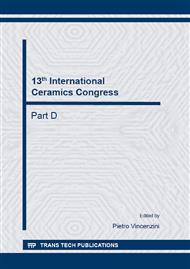[1]
T. Ogawa, M. Furukawa and T. Tsukada, Poling Field Dependence of Piezoelectric Properties and Hysteresis Loops of Polarization versus Electric Field in Alkali Niobate Ceramics, Jpn. J. Appl. Phys. 48 (2009) 709KD07-1-5.
DOI: 10.1143/jjap.48.09kd07
Google Scholar
[2]
T. Ogawa, T. Nishina, M. Furukawa and T. Tsukada, Poling Field Dependence of Ferroelectric Properties in Alkali Bismuth Titanate Lead-Free Ceramics, Jpn. J. Appl. Phys. 49 (2010) 09MD 07-1-4.
DOI: 10.1143/jjap.49.09md07
Google Scholar
[3]
T. Ogawa, Poling Field Dependence of Ferroelectric Properties in Barium Titanate Ceramics, Jpn. J. Appl. Phys. 40 (2001) 5630-5633.
DOI: 10.1143/jjap.40.5630
Google Scholar
[4]
M. Furukawa, T. Tsukada, D. Tanaka and N. Sakamoto, Alkaline Niobate-Based Lead-Free Piezoelectric Ceramics, Proc. 24th Int. Japan-Korea Semin. Ceramics (2007) 339-342.
Google Scholar
[5]
T. Ogawa, A. Yamada, Y.K. Chung and D.I. Chun, Effect of Domain Structures on Electrical Properties in Tetragonal PZT Ceramics, J. Korean Phys. Soc. 32 (1998) S724-S726.
Google Scholar
[6]
T. Ogawa and K. Nakamura, Poling Field Dependence of Ferroelectric Properties and Crystal Orientation in Rhombohedral Lead Zirconate Titanate Ceramics, Jpn. J. Appl. Phys. 37 (1998) 5241-5245.
DOI: 10.1143/jjap.37.5241
Google Scholar
[7]
T. Ogawa and K. Nakamura, Effect of Domain Switching and Rotation on Dielectric and Piezo- electric Properties in Lead Zirconate Titanate Ceramics, Jpn. J. Appl. Phys. 38 (1999) 5465-5469.
DOI: 10.1143/jjap.38.5465
Google Scholar
[8]
T. Ogawa, Domain Switching and Rotation in Lead Zirconate Titanate Ceramics by Poling Fields, Ferroelectrics 240 (2000) 75-82.
DOI: 10.1080/00150190008227955
Google Scholar
[9]
T. Ogawa, Domain Structure of Ferroelectric Ceramics, Ceram. Int. 25 (2000) 383-390.
Google Scholar
[10]
T. Ogawa, Poling Field Dependence of Crystal Orientation and Ferroelectric Properties in Lead Titanate Ceramics, Jpn. J. Appl. Phys. 39 (2000) 5538-5541.
DOI: 10.1143/jjap.39.5538
Google Scholar
[11]
T. Ogawa, Poling Field Dependence of Ferroelectric Properties in Piezoelectric Ceramics and Single Crystal, Ferroelectrics 273 (2002) 371-376.
DOI: 10.1080/713716341
Google Scholar
[12]
R. Kato and T. Ogawa, Chemical Composition Dependence of Giant Piezoelectricity on k31 Mode in Pb(Mg1/3Nb2/3)O3-PbTiO3 Single Crystals, Jpn. J. Appl. Phys. 45 (2006) 7418-7421.
DOI: 10.1143/jjap.45.7418
Google Scholar
[13]
T. Ogawa, Giant k31 Relaxor Single-Crystal Plate and Their Applications, in: M. Lallart (Ed. ), Ferroelectrics -Applications-, Intech Open Access Publisher, Croatia, 2011, pp.3-34.
DOI: 10.5772/19117
Google Scholar
[14]
T. Ogawa and T. Nishina, Acoustic Wave Velocities Measurement on Piezoelectric Ceramics to Evaluate Young's Modulus and Poisson's Ratio for Realization of High Piezoelectricity, in: K.M. Nair, S. Priya (Eds. ), Ceramic Transactions, Advances and Applications in Electroceramics II, John Wiley Publication, Hoboken, NJ, Vol. 235, 2012, pp.105-112.
DOI: 10.1002/9781118511350.ch11
Google Scholar
[15]
T. Ogawa, K. Ishii, T. Matsumoto and T. Nishina, Poling Field Dependence of Longitudinal and Transverse Wave Velocities, Young's Modulus, and Poisson's Ratio in Piezoelectric Ceramics, J. Appl. Phys. 51 (2012) 09LD03-1-5.
DOI: 10.7567/jjap.51.09ld03
Google Scholar
[16]
T. Ogawa, Acoustic Wave Velocity Measurement on Piezoelectric Ceramics, in: F. Ebrahimi (Ed. ), Piezoelectric Materials and Devices -Practice and Applications-, Intech Open Access Publisher, Croatia, 2013, pp.35-52.
DOI: 10.5772/53117
Google Scholar
[17]
T. Ogawa, Highly Functional and High-Performance Piezoelectric Ceramics, Ceramic Bulletin 70 (1991) 1042-1049.
Google Scholar
[18]
Olympus, Ultrasonic Precision Thickness Gages User's Manual, Part No. 910-261-EN, Revision H.
Google Scholar
[19]
B. Jaffe, W.R. Cook and H. Jaffe, Piezoelectric Ceramics, Academic Press, London, (1971).
Google Scholar
[20]
Landolt-Bornstein Group III: Condensed Matter, Ferroelectrics and Related Substances, Springer, Berlin, 36A1, (2001).
Google Scholar
[21]
Landolt-Bornstein Group III: Condensed Matter, Ferroelectrics and Related Substances, Springer, Berlin, 36A2, (2002).
Google Scholar


